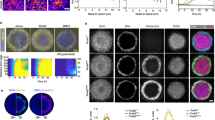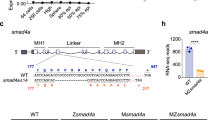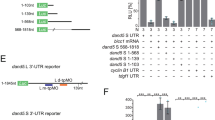Abstract
In the chick embryo, left–right asymmetric patterns of gene expression in the lateral plate mesoderm are initiated by signals located in and around Hensen's node. Here we show that Caronte (Car), a secreted protein encoded by a member of the Cerberus/Dan gene family, mediates the Sonic hedgehog (Shh)-dependent induction of left-specific genes in the lateral plate mesoderm. Car is induced by Shh and repressed by fibroblast growth factor-8 (FGF-8). Car activates the expression of Nodal by antagonizing a repressive activity of bone morphogenic proteins (BMPs). Our results define a complex network of antagonistic molecular interactions between Activin, FGF-8, Lefty-1, Nodal, BMPs and Car that cooperate to control left–right asymmetry in the chick embryo.
This is a preview of subscription content, access via your institution
Access options
Subscribe to this journal
Receive 51 print issues and online access
$199.00 per year
only $3.90 per issue
Buy this article
- Purchase on Springer Link
- Instant access to full article PDF
Prices may be subject to local taxes which are calculated during checkout








Similar content being viewed by others
References
Levin,M., Johnson,R. L., Stern,C. D., Kuehn,M. & Tabin,C. A molecular pathway determining left-right asymmetry in chick embryogenesis. Cell 82, 803–814 (1995).
Harvey,R. P. Links in the left/right axial pathway. Cell 94, 273–276 (1998).
Ramsdell,A. F. & Yost,H. J. Molecular mechanisms of vertebrate left-right development. Trends Genet. 14, 459–465 (1998).
King,T. & Brown,N. A. Embryonic asymmetry: the left side gets all the best genes. Curr. Biol. 9, R18–R22 (1999).
Collignon,J., Varlet,I. & Robertson,E. J. Relationship between asymmetric nodal expression and the direction of embryonic turning. Nature 381, 155–158 (1996).
Lowe,L. A. et al. Conserved left-right asymmetry of nodal expression and alterations in murine situs inversus. Nature 381, 158–161 (1996).
Supp,D. M., Witte,D. P., Potter,S. S. & Brueckner,M. Mutation of an axonemal dynein affects left-right asymmetry in inversus viscerum mice. Nature 389, 963–966 (1997).
Hyatt,B. A., Lohr,J. L. & Yost,H. J. Initiation of vertebrate left-right axis formation by maternal vg1. Nature 384, 62–65 (1996).
Lohr,J. L., Danos,M. C. & Yost,H. J. Left-right asymmetry of a nodal-related gene is regulated by dorsoanterior midline structures during Xenopus development. Development 124, 1465–1472 (1997).
Pagán-Westphal,S. M. & Tabin,C. J. The transfer of left-right positional information during chick embryogenesis. Cell 93, 25–35 (1998).
Levin,M., Roberts,D. J., Holmes,L. B. & Tabin,C. Laterality defects in conjoined twins. Nature 384, 321 (1996).
Meno,C. et al. Lefty-1 is required for left-right determination as a regulator of Lefty-2 and Nodal. Cell 94, 287–297 (1998).
Yoshioka,H. et al. Pitx2, a bicoid-type homeobox gene, is involved in a lefty-signaling pathway in determination of left-right asymmetry. Cell 94, 299–305 (1998).
Boettger,T., Wittler, L. & Kessel,M. FGF8 functions in the specification of the right body side of the chick. Curr. Biol. 9, 277–280 (1999).
Isaac,A., Sargent,M. G. & Cooke,J. Control of vertebrate left-right asymmetry by a Snail-related zinc finger gene. Science 275, 1301–1304 (1997).
Ryan,A. K. et al. Pitx2 determines left-right asymmetry of internal organs in vertebrates. Nature 394, 545–551 (1998).
Campione,M. et al. The homeobox gene Pitx2: mediator of asymmetric left-right signaling in vertebrate heart and gut looping. Development 126, 1225–1234 (1999).
Bouwmeester,T., Kim,S. H., Sasai,Y., Lu,B. & De Robertis,E. M. Cerberus is a head-inducing secreted factor expressed in the anterior endoderm of Spemann's organizer. Nature 382, 595–601 (1996).
Hsu,D. R., Economides,A. N., Wang,X., Eimon,P. M. & Harland, R. M. The Xenopus dorsalizing factor Gremlin identifies a novel family of secreted proteins that antagonize BMP activities. Mol. Cell 1, 673–683 (1998).
Ozaki,T. & Sakiyama,S. Molecular cloning and characterization of a cDNA showing negative regulation in v-src-transformed 3Y1 rat fibroblasts. Proc. Natl Acad. Sci. USA 90, 2593–2597 (1993).
Stanley,E. et al. Dan is a secreted glycoprotein related to Xenopus cerebus. Mech. Dev. 77, 173–184.
Belo,J. A. Cerberus-like is a secreted factor with neuralizing activity expressed in the anterior primitive endoderm of the mouse gastrula. Mech. Dev. 68, 45–57 (1997).
Thomas,P., Brickman,J. M., Popperl,H., Krumlauf, R. & Beddington,R. S. Axis duplication and anterior identity in the mouse embryo. Cold Spring Harb. Symp. Quant. Biol. 62, 115–125 (1997).
Biben,C. et al. Murine cerberus homologue mCer-1: a candidate anterior patterning molecule. Dev. Biol. 194, 135–151 (1998).
Topol,L. Z. et al. Identification of drm, a novel gene whose expression is suppressed in transformed cells and which can inhibit growth of normal but not transformed cells in culture. Mol. Cell. Biol. 17, 4801–4810 (1997).
Pearce,J. J., Penny,G. & Rossant,J. A mouse Cerberus/Dan-related gene family. Dev. Biol. 209, 98–110 (1999).
Yokouchi,Y., Vogan,K. J., Pearse II, R. V. & Tabin,C. J. Antagonistic signaling by Caronte, a novel Cerberus-related gene, mediates the establishment of broad domains of left-right asymmetric gene expression. Cell (in the press).
Zhu,L. et al. Cerberus regulates left/right asymmetry of the embryonic head and heart. Curr. Biol. 9, 931–938 (1999).
Thisse,C. & Thisse,B. Antivin, a novel and divergent member of the TGFβ superfamily, negatively regulates mesoderm induction. Development 126, 229–240 (1999).
Meno,C. et al. Two closely-related left-right asymmetrically expressed genes, lefty-1 and lefty-2: their distinct expression domains, chromosomal linkage and direct neuralizing activity in Xenopus embryos. Genes Cells 2, 513–524 (1997).
Oulad-Abdelghani,M. et al. Stra3/lefty, a retinoic acid-inducible novel member of the transforming growth factor-β superfamily. Int. J. Dev. Biol. 42, 22–32 (1998).
Schneider,A. et al. the homeobox gene NKX3.2 is a target of left–right signalling and is expressed on opposite sides in chick and mouse embryos. Curr. Biol. 9, 911–914 (1999).
Piccolo,S. et al. The head inducer Cerberus is a multifunctional antagonist of Nodal, BMP and Wnt signals. Nature 397, 707–710 (1999).
Watanabe,Y. & Le Douarin,N. M. A role for BMP-4 in the development of subcutaneous cartilage. Mech. Dev. 57, 69–78 (1996).
Schultheiss,T. M., Burch,J. B. & Lassar,A. B. A role for bone morphogenetic proteins in the induction of cardiac myogenesis. Genes Dev. 11, 451–462 (1997).
Streit,A. et al. Chordin regulates primitive streak development and the stability of induced neural cells, but is not sufficient for neural induction in the chick embryo. Development 125, 507–519 (1998).
Zimmerman,L. B., De Jesus-Escobar,J. M. & Harland, R. M. The Spemann organizer signal noggin binds and inactivates bone morphogenetic protein 4. Cell 86, 599–606 (1996).
Capdevila,J. & Johnson, R. L. Endogenous and ectopic expression of noggin suggests a conserved mechanism for regulation of BMP function during limb and somite patterning. Dev. Biol. 197, 205–217 (1998).
Pizette,S. & Niswander, L. BMPs negatively regulate structure and function of the limb apical ectodermal ridge. Development 126, 883–894 (1999).
Thompson,J. D., Gibson,T. J., Plewniak,F., Jeanmougin,F. & Higgins,D. G. The CLUSTAL_X windows interface: flexible strategies for multiple sequence alignment aided by quality analysis tools. Nucleic Acids Res. 25, 4876–4882 (1997).
Mohammadi,M. et al. Structures of the tyrosine kinase domain of fibroblast growth factor receptor in complex with inhibitors. Science 276, 955–960 (1997).
Izpisua-Belmonte,J. C., De Robertis, E. M., Storey, K. G. & Stern, C. D. The homeobox gene goosecoid and the origin of organizer cells in the early chick blastoderm. Cell 74, 645–659 (1993).
Tribioli,C., Frasch,M. & Lufkin,T. Bapx1: an evolutionary conserved homologue of the Drosophila bagpipe homeobox gene is expressed in splanchnic mesoderm and the embryonic skeleton. Mech. Dev. 65, 145–162 (1997).
Olson,E. N. & Srivastava,D. Molecular pathways controlling heart development. Science 272, 671–676 (1996).
Harvey,R. P. NK-2 homeobox genes and heart development. Dev. Biol. 178, 203–216 (1996).
Meyers,E. N. & Martin, G. R. Differences in left-right axis pathways in mouse and chick: functions of FGF8 and SHH. Science 285, 403–406 (1999).
Izraeli,S. et al. The SIL gene is required for mouse embryonic axial development and left-right specification. Nature 399, 691–694 (1999).
Tsukui,T. et al. Multiple left-right asymmetry defects in Shh-/- mutant mice unveil a convergence of the Shh and Retinoic Acid pathways in the control of Lefty-1. Proc. Natl Acad. Sci. USA (in the press).
New,D. A. T. A new technique for the cultivation of the chick embryo in vitro. J. Embryol. Exp. Morphol. 3, 326–331 (1955).
Merino, et al. Expression and function of Gdf-5 during digit skeletogenesis in the embryonic chick leg bud. Dev. Biol. 206, 33–45 (1999).
Acknowledgements
We thank J. Magallón for technical help; T. Brand, R. Evans, H. Hamada, C. Kintner, G. Rosenfeld, C. Stern, C. Tabin and members of P. E. Wright's group for discussions and for sharing unpublished observations; W. Vale and S. Choe for reagents; J. P. Fandl (for providing human Cerberus) and X. Wang (for technical help), both at Regeneron; J. Hurlé for scanning images; C. Parada for suggesting the name Caronte; and L. Hooks for help in preparing the manuscript. J.C. was supported by a Hoffmann Foundation Fellowship; J.P. was supported by a long-term EMBO Fellowship. This work was supported by grants from the G. Harold and Leila Y. Mathers Charitable Foundation and the NIH to J.C.I.B., who is a Pew Scholar.
Author information
Authors and Affiliations
Corresponding author
Supplementary information
Rights and permissions
About this article
Cite this article
Esteban, C., Capdevila, J., Economides, A. et al. The novel Cer-like protein Caronte mediates the establishment of embryonic left–right asymmetry. Nature 401, 243–251 (1999). https://doi.org/10.1038/45738
Received:
Accepted:
Issue Date:
DOI: https://doi.org/10.1038/45738
This article is cited by
-
Establishment of left–right asymmetry in vertebrate development: the node in mouse embryos
Cellular and Molecular Life Sciences (2013)
-
Characterization of Cer-1 cis-regulatory region during early Xenopus development
Development Genes and Evolution (2011)
-
TGFβ signaling in Tribolium: vertebrate-like components in a beetle
Development Genes and Evolution (2008)
-
Molecular approaches to brain asymmetry and handedness
Nature Reviews Neuroscience (2006)
Comments
By submitting a comment you agree to abide by our Terms and Community Guidelines. If you find something abusive or that does not comply with our terms or guidelines please flag it as inappropriate.



